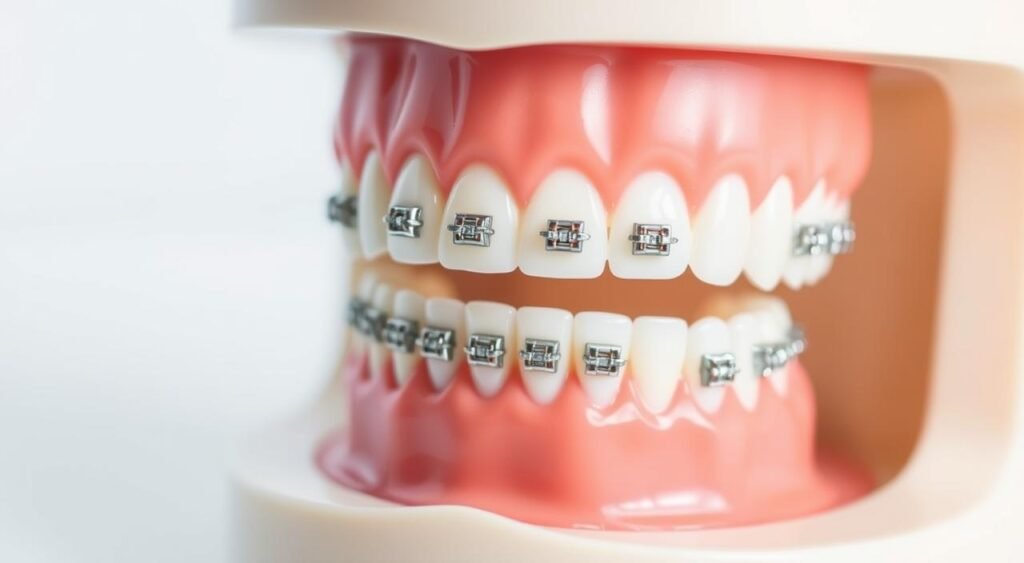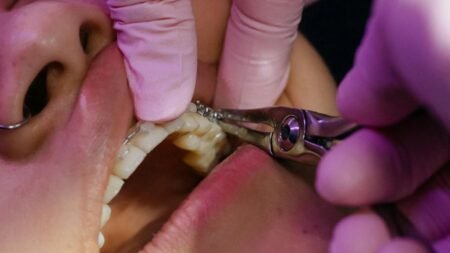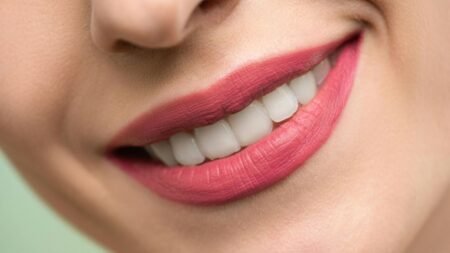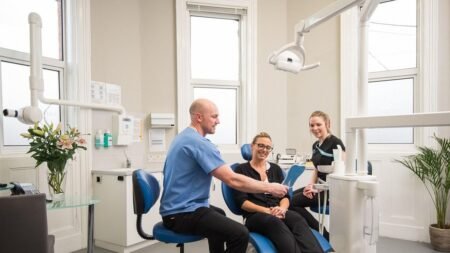Ever thought about how braces on crooked teeth can transform not just your smile, but your whole life? Braces on crooked teeth do more than just improve your appearance. They play a key role in enhancing oral health, boosting self-confidence, and paving the way for a brighter future.
Braces on crooked teeth have come a long way from the traditional metal look. Today, they combine art and science to move your teeth into perfect alignment. With precision, they address issues like overcrowding, gaps, or misalignment, transforming your smile and improving overall dental health.
Getting straight teeth with braces is more than about looks. Misaligned teeth can lead to tooth decay, gum disease, and headaches. Braces fix these problems, making it easier to keep your mouth healthy.
Today, there are many types of braces, from traditional metal to almost invisible ones. Let’s dive into the world of braces. You’ll see how this treatment can change your smile and boost your confidence in amazing ways.
- Crooked Teeth and Their Impact
- The Science Behind Braces and Teeth Alignment
- Types of Braces for Correcting Crooked Teeth
- Braces on Crooked Teeth: The Transformation Process
- Benefits of Straightening Crooked Teeth with Braces
- Life with Braces: Care, Maintenance, and Adjustments
- Conclusion: Embracing Your New Smile
Crooked Teeth and Their Impact
Crooked teeth, or malocclusion, are common dental issues that can be mild or severe. These misalignments can greatly affect your oral health and overall well-being. Can braces fix crooked teeth? Yes, they can, and it’s important to know why and how.
Common Causes of Misaligned Teeth
Several factors lead to crooked teeth:
- Genetics play a big role, with a high chance of inheriting misalignment from family members
- Childhood habits like prolonged thumb-sucking or pacifier use
- Premature loss of baby teeth
- Jaw size discrepancies leading to crowding or spacing issues
- Oral injuries from accidents or falls
- Chronic mouth breathing affecting tooth positioning
Oral Health Concerns Associated with Crooked Teeth
Misaligned teeth can cause oral health problems:
- Increased risk of tooth decay due to difficulty in cleaning tight spaces
- Higher susceptibility to gum disease from bacteria accumulation
- Uneven wear on teeth, potentially leading to chipping or cracking
- Jaw pain, headaches, and ear discomfort
- Challenges in chewing and digestion
Aesthetic and Psychological Effects
Crooked teeth affect more than just oral health:
- Reduced self-confidence and self-esteem
- Potential speech impediments
Orthodontic treatment can improve oral health and mental well-being. The cost of braces may vary, but the long-term benefits are often worth it. There are various orthodontic options, from traditional braces to clear aligners, tailored to your needs and goals.
| Treatment Option | Effectiveness | Visibility | Typical Treatment Duration |
|---|---|---|---|
| Traditional Metal Braces | High | Visible | 18-24 months |
| Ceramic Braces | High | Less visible | 18-24 months |
| Lingual Braces | High | Hidden | 18-24 months |
| Clear Aligners | Moderate to High | Nearly invisible | 12-18 months |
The Science Behind Braces and Teeth Alignment
Braces for crooked teeth use a scientific process to move teeth into place. They apply gentle pressure over time. This pressure works on the periodontal ligament, which holds teeth but lets them move.
Braces have brackets on each tooth, archwires to guide movement, and elastic bands for force. These parts work together to move teeth. Orthodontists plan and adjust the treatment for the best results.
Teeth braces may cause some discomfort, but the benefits last a long time. Adjustments every 4-6 weeks are key to keeping the treatment on track.
There are different types of braces, each with its own benefits:
- Traditional metal braces: Most common and effective for complex cases
- Ceramic braces: Less noticeable than metal ones
- Lingual braces: Virtually invisible as they’re placed behind teeth
- Clear aligners: Nearly invisible and removable
Orthodontic treatment can last 1-3 years. After, wearing a retainer keeps the teeth in place. It supports bone tissue as it settles around the tooth sockets.
Types of Braces for Correcting Crooked Teeth
Braces are great for fixing crooked teeth. Your orthodontist will suggest the best one for you, considering your needs and budget. Let’s look at the main types of braces available today.

Traditional Metal Braces
Metal braces are a top choice for straightening teeth. They use brackets and wires to move teeth into the right spot. They’re the most affordable option and very effective.
Ceramic Braces
Ceramic braces are like metal ones but blend in with your teeth. They’re less visible, perfect for those wanting a discreet fix. They cost a bit more but work well for straightening teeth.
Lingual Braces
Lingual braces sit on the inside of your teeth, making them almost invisible. They’re made just for you, offering a hidden fix. They’re pricier and might take longer to get used to.
Clear Aligners
Clear aligners, like Invisalign, use trays to move teeth over time. They’re almost invisible and can be taken out to eat and clean. They’re great for small to moderate fixes, especially for adults.
| Brace Type | Visibility | Effectiveness | Cost Range |
|---|---|---|---|
| Metal Braces | Visible | High | $3,000 – $7,000 |
| Ceramic Braces | Less Visible | High | $4,000 – $8,000 |
| Lingual Braces | Hidden | High | $8,000 – $10,000 |
| Clear Aligners | Nearly Invisible | Moderate to High | $3,000 – $7,000 |
Braces on Crooked Teeth: The Transformation Process
Your journey to a straighter smile starts with a consultation. An orthodontist will check your teeth and talk about what you want for your smile. They will suggest the best braces for you. You might wonder “crooked teeth braces how long” at this point.
Most people wear braces for 1.5 to 2 years. The time needed depends on how crooked your teeth are. Some might need up to three years for perfect alignment. There’s no age limit for getting braces. Both kids and adults can get them.
After getting braces, you’ll visit your orthodontist regularly. These visits are for adjusting your braces and checking how they’re working. Traditional metal braces cost between $3,000 and $7,000.
| Treatment Type | Average Duration | Cost Range |
|---|---|---|
| Traditional Metal Braces | 18-24 months | $3,000-$7,000 |
| Clear Aligners | 12-18 months | $4,000-$8,000 |
| Lingual Braces | 18-36 months | $8,000-$10,000 |
After your braces come off, you start the retention phase. You’ll wear a retainer to keep your teeth in place. Being patient is key in this process. Sticking to your treatment plan will give you a beautiful smile.
Benefits of Straightening Crooked Teeth with Braces
Braces can do more than just make your smile look better. They have many advantages for your health and daily life. Let’s look at the main benefits of straight teeth with braces.
Improved Oral Health and Hygiene
Braces help you clean your mouth better. When your teeth are straight, brushing and flossing become easier. This lowers the chance of cavities and gum disease. Crooked teeth can make cleaning hard, leading to inflammation and gum issues.
Enhanced Bite Function and Speech
Braces make your bite work better, which helps with digestion and overall health. They also improve how you speak, making it clearer within six months of treatment.
Boost in Self-Confidence
Having straight teeth can make you feel more confident. Many people feel more at ease smiling and talking in public after braces. This boost in confidence can change many areas of your life for the better.
| Benefit | Impact |
|---|---|
| Oral Health | Reduced risk of tooth decay and gum disease |
| Functionality | Improved chewing efficiency and speech |
| Confidence | Increased self-esteem and social comfort |
| Long-term Health | Less wear on teeth, gums, and jaw |
Many Americans, over four million, choose braces for crooked teeth. The benefits go beyond looks, helping your dental health and well-being. Fixing misalignments means you’re not just getting a better smile. You’re also investing in a healthier future for your teeth and gums.
Life with Braces: Care, Maintenance, and Adjustments
Living with braces means you need to be dedicated and careful. The process usually takes 18 to 24 months. You’ll have to change your daily habits to get the best results and avoid problems.
Keeping your mouth clean is very important. Make sure to brush at least twice a day. Use special tools for flossing around the brackets and wires. This helps prevent stains and bacteria, which can cause cavities or gum disease.
After your braces get adjusted, you might feel a bit sore for a few days. Over-the-counter pain relievers can help ease the pain. If you notice sharp edges, use orthodontic wax to protect your mouth.
Your eating habits will also change. Avoid eating hard and sticky foods that can harm your braces. This keeps your treatment working well and cuts down on extra visits to the orthodontist.
| Do’s | Don’ts |
|---|---|
| Brush after every meal | Eat hard candies or nuts |
| Use a soft-bristled toothbrush | Chew gum |
| Floss daily with special tools | Bite into whole apples or corn on the cob |
| Wear a mouthguard for sports | Open packages with your teeth |
Remember, taking good care of your braces is crucial for your smile. Stick to your oral health routine, and soon you’ll be showing off your new smile!
Conclusion: Embracing Your New Smile
Braces can change your life by improving your oral health and boosting your confidence. You can choose from traditional metal braces or clear aligners that fit your lifestyle. Getting straight teeth with braces takes time, but it’s worth it.
Having crooked teeth can cause problems like plaque buildup and gum disease. Choosing orthodontic treatment helps improve your smile and protects your health. You can pick ceramic braces for a less visible option or lingual braces for complete invisibility.
After getting your new smile, remember to wear retainers as your dentist says. Thanks to 3D printing and digital monitoring, orthodontic treatment is now more efficient and comfy. Getting straight teeth means better health and more confidence for you.
FAQ – Crooked Teeth and Braces
What causes crooked teeth?
Genetics, thumb-sucking, or trauma can cause crooked teeth. Inherited traits often lead to overcrowding and misalignment.
How do braces fix crooked teeth?
Braces apply pressure over time to move teeth. As teeth shift, the bone changes to fit their new spots.
What are the different types of braces for crooked teeth?
You can choose from traditional metal, ceramic, lingual, or clear aligners like Invisalign.
How long does it take to straighten crooked teeth with braces?
Treatment time varies by how crooked your teeth are. It usually takes 18 months to 3 years.
Are there age limits for getting braces to fix crooked teeth?
No, braces are for both kids and adults. They help straighten teeth at any age.
What are the benefits of straightening crooked teeth?
Straight teeth mean better oral hygiene and less risk of decay and gum disease. You’ll also have a better bite, fewer speech issues, less jaw pain, and more confidence.
Are there any side effects or discomfort with braces?
You might feel some discomfort after a brace adjustment. But, over-the-counter pain relievers can help. Using orthodontic wax and good oral hygiene prevents irritation.
How much do braces for crooked teeth cost?
Braces cost vary by type, case severity, and treatment length. For an exact price, talk to an orthodontist.









1 Comment
Pingback: Impacted K9 Teeth: Causes, Symptoms & Treatment Options